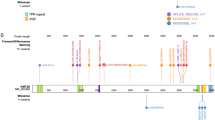Abstract
CD3δ deficiency is a recently identified rare form of severe combined immunodeficiency. We analysed the CD3δ gene in a Japanese family with severe combined immunodeficiency. The patients lacked T-cells with normal numbers of B-cells and natural killer cells in peripheral blood. We found a novel homozygous mutation in the splicing acceptor site of intron 2 (IVS2–2A→G) in these patients. Analysis of patients’ mononuclear cells revealed the CD3δ splicing abnormality. Chest X-ray films and computed tomography revealed small sized thymuses in these patients. Conclusion:The CD3δ gene should be analysed in patients with severe combined immunodeficiency lacking T-cells with normal B- and natural killer cells irrespective of the thymus size.


Similar content being viewed by others
Abbreviations
- NK :
-
natural killer
- SCID :
-
severe combined immunodeficiency
References
Ammann AJ, Hong R (1989) Disorders of the T-cell system. In: Stiem ER (ed) Immunologic disorders in infants and children, 3rd edn. Saunders, Philadelphia, pp 257–315
Arnaiz-Villena A, Timon M, Corell A, Perez-Aciego P, Martin-Villa JM, Regueiro JR (1992) Primary immunodeficiency caused by mutations in the gene encoding the CD3-γ subunit of the T-lymphocyte receptor. N Engl J Med 327: 529–533
Berger MA, Dave V, Rhodes MR, Bosma GC, Bosma MJ, Kappes DJ, Wiest DL (1997) Subunit composition of pre-T-cell receptor complexes expressed by primary thymocytes: CD3δ is physically associated but not functionally required. J Exp Med 186: 1461–1467
Dadi HK, Simon AJ, Roifman CM (2003) Effect of CD3δ deficiency on maturation of α/β and γ/δ T-cell lineages in severe combined immunodeficiency. N Engl J Med 349: 1821–1828
Dave VP, Cao Z, Browne C, Alarcon B, Fernandez-Miguel G, Lafaille J, De la Hera A, Tonegawa S, Kappes DJ (1997) CD3δ deficiency arrests development of the αβ but not the γδ T cell lineage. EMBO J 16: 1360–1370
Delgado P, Fernandez E, Dave V, Kappes D, Alarcon B (2000) CD3δ couples T-cell receptor signalling to ERK activation and thymocyte positive selection. Nature 406: 426–430
De Saint Basile G, Geissmann F, Flori E, Uring-Lambert B, Soudais C, Cavazzana-Calvo M, Durandy A, Jabado N, Fischer A, Le Deist F (2004) Severe combined immunodeficiency caused by deficiency in either the delta or the epsilon subunit of CD3. J Clin Invest 114: 1512–1517
Puel A, Ziegler SF, Buckley RH, Leonard W (1998) Defective IL7R expression in T-B+NK+ severe combined immunodeficiency. Nature Genet 20: 394–397
Phillips JH, Hori T, Nagler A, Bhat N, Spits H, Lanier LL (1992) Ontogeny of human natural killer (NK) cells: fetal NK cells mediate cytolytic function and express cytoplasmic CD3ε, δ proteins. J Exp Med 175: 1055–1066
Soudais C, de Villartay JP, Le Deist F, Fischer A, Lisowska-Grospierre B (1993) Independent mutations of the human CD3-ε gene resulting in a T cell receptor/CD3 complex immunodeficiency. Nat Genet 3: 77–81
Von Boehmer H, Fehling HJ (1997) Structure and function of the pre-T cell receptor. Annu Rev Immunol 15: 433–452
Author information
Authors and Affiliations
Corresponding author
Rights and permissions
About this article
Cite this article
Takada, H., Nomura, A., Roifman, C.M. et al. Severe combined immunodeficiency caused by a splicing abnormality of the CD3δ gene. Eur J Pediatr 164, 311–314 (2005). https://doi.org/10.1007/s00431-005-1639-6
Received:
Accepted:
Published:
Issue Date:
DOI: https://doi.org/10.1007/s00431-005-1639-6




